Only 20% of drivers use Do Not Disturb While Driving. Do you?
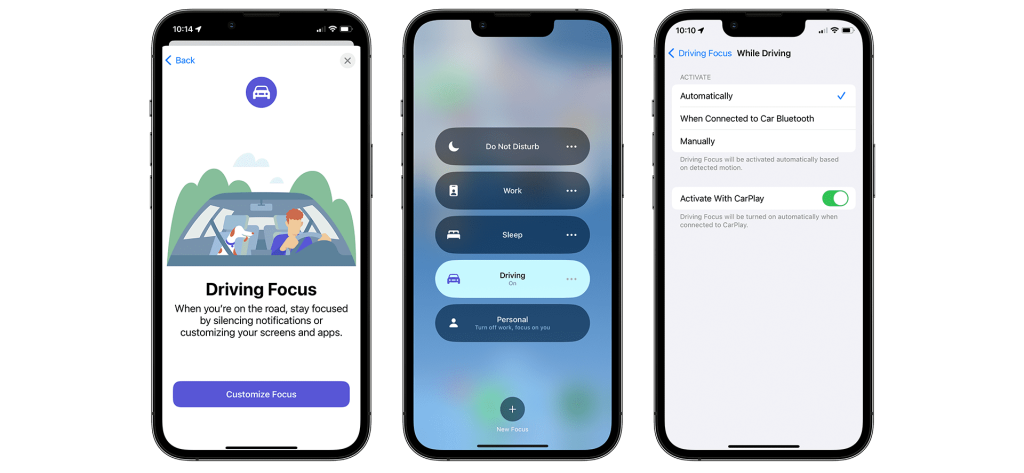
It’s been over six years since Apple introduced Do Not Disturb While Driving (DNDWD) with iOS 11. Since then, the feature that blocks incoming notifications as you drive has gone through many changes. It’s expanded to other areas of life, like sleep, fitness, and work focus. The framing of the feature has changed as well — instead of do not disturb, it’s now framed as focus. (We’ll still refer to it as DNDWD here.) In addition to Automatic, Bluetooth Enabled, and Manual, you can also activate it when connecting your phone to Apple’s CarPlay.
Apple’s Health app has also grown over the years to provide new safety features. It uses checklists to notify users if they’ve been listening to music too loud, if they have irregular or high heart rates, and more. DNDWD, a driving safety feature, isn’t on the list.
Similar features are available across the Android ecosystem and with Android Auto.
Despite the changes, the one feature that would help drive adoption and reduce distracted driving — making DNDWD opt-out — is still absent on both iPhone and Android phones.
To uncover the state of DNDWD, we surveyed over 1,000 US drivers to understand their awareness and usage of the safety feature. What we discovered was that while over 60% of drivers are aware of DNDWD, only 20% frequently use it. Let’s find out why.
Who’s aware of DNDWD?
Out of the 1,000-plus drivers we surveyed, 62% were aware of DNDWD. Awareness of DNDWD declines as drivers get older. Eighteen-to-29-year-olds have the highest level of awareness at 75%. Thirty-to-44-year-olds have slightly lower awareness, with 72%. Awareness among 45-60-year-olds continues to drop, falling to 68%. Drivers over 60 have the lowest awareness — only 44% are familiar with DNDWD.
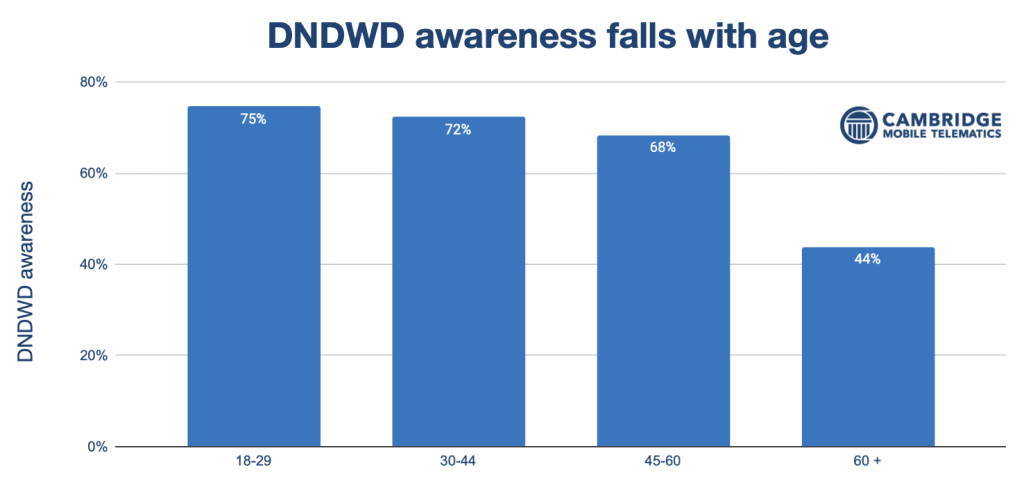
There was a difference in awareness among Android and iPhone users as well. iPhone users show a much higher level of awareness for DNDWD with 68%. Android users’s awareness for DNDWD was 55%, a 13-point difference.
Drivers across age spectrums discover DNDWD in a similar way — 60% learn about it from their smartphones. The rate varies slightly among age groups, but not by much. The same is true of iPhone and Android users — both hover around discovering DNDWD on their phones at 60%. This finding speaks to the importance of tech literacy for increasing DNDWD activation rates and the need for more promotion within the mobile operating systems themselves.
“I heard about this feature through a friend. I think there should be more social media marketing. I would think blasting it more that way can bring more awareness to the younger groups.” — Emily Bishonio
Beyond smartphones, personal relationships play a significant role in spreading awareness. Among respondents aware of DNDWD, 25% learned about the feature from friends and family. The 60-plus group overindexes here, with 33% of them learning from friends and family.
20% of drivers use DNDWD
Despite 62% of drivers being aware of DNDWD, only 20% of drivers consistently use it. Younger drivers, aged 18-29 years, are the most active users, with 29% claiming they always or often use it.
“It’s annoying when it comes on when I’m not driving. But other than that, I find it quite helpful.” — Eva Davenport
As with the awareness of DNDWD, the use drops as age rises. Just 25% of 30-44-year-olds frequently use DNDWD, while use among the 40-60 age group falls to 22%. Only 10% of drivers over 60 years old use DNDWD. (Older drivers make up a larger percentage of our respondents, bringing down overall usage rates.)
These findings show that younger age groups, which are typically more technically savvy, have higher levels of awareness and DNDWD activation rates. Older drivers have lower awareness and might struggle setting up these features for their driving routine.
Beyond age differences, we found that iPhone users activate DNDWD at slightly higher levels than Android users, 22% and 19%, respectively. However, more iPhone users rarely or never use DNDWD. Thirty-three percent of iPhone users fall into the rarely/never use segment compared to 27% for Android.
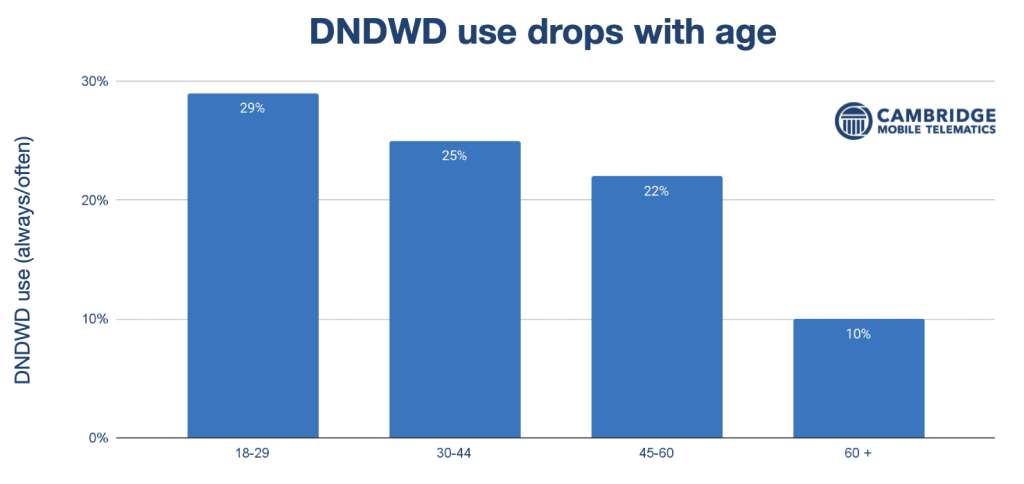
74% say DNDWD makes them a safer driver
The primary reason people activate DNDWD is to drive safer. They recognize the distractions caused by the phone and use DNDWD to combat them. Fifty-five percent use DNDWD to reduce their own distracted driving.
“I think if we implemented it, the roads would be a lot safer and it would be a good thing to stop distracted driving.” — Sean Coutinho
Drivers love the product. When they use DNDWD, it has an overwhelmingly positive response. Eighty-eight percent of users say that other drivers would benefit from it and that they should turn it on. Seventy-four percent says it makes them a safer driver.
Why don’t drivers use DNDWD?
DNDWD offers advantages by helping drivers focus on the road, free from distractions like texts, calls, and other notifications. So, why don’t all drivers turn it on?
“I didn’t even know DNDWD was an option. I just have my phone on vibrate all the time. I prefer getting the notifications so I know to check my phone as soon as I’m done driving.” — Will Wavford
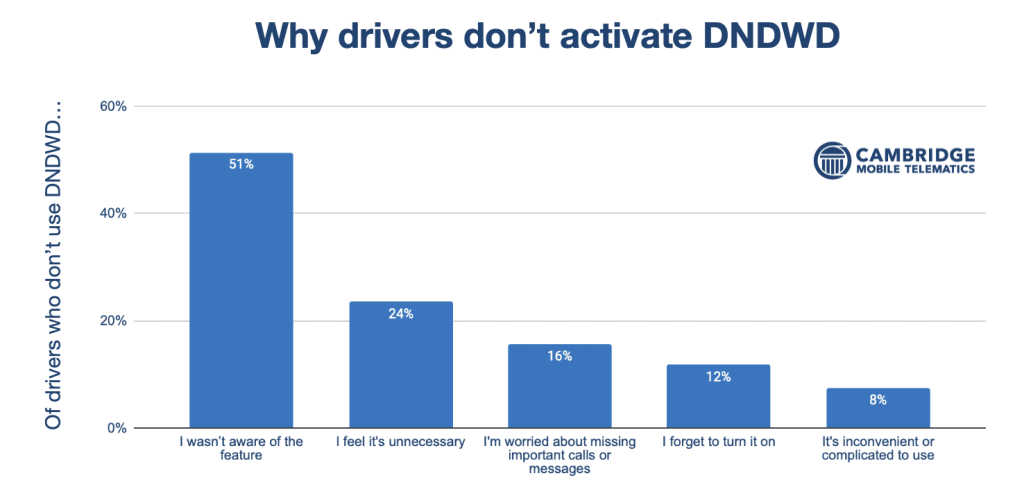
Of the drivers who don’t use DNDWD, the primary reason is a lack of awareness. Fifty-one percent of drivers who don’t use DNDWD said they didn’t know about it. We asked them: Now that they’re aware of the feature after taking the survey, would they turn it on? Only 31% said yes. This result suggests that awareness isn’t the only challenge we face in increasing DNDWD activation.
Other reasons for not using DNDWD include that 24% of drivers don’t think it’s necessary. Sixteen percent of 18-29-year-olds said it’s unnecessary, the highest of any age group.
Nine percent worry about missing calls or messages, with the youngest segment over-indexing at 13%.
“I don’t use it because I’m worried that someone is going to send me an important text or call while I’m driving.” — Adrienne Arnold
Complexity or inconvenience was a deterrent for 8%.
“Obviously there are pros to it. I just think that the annoyances get in the way of those pros.” — Arian Omidi
Forgetting to activate it accounts for 12%.
For all the respondents who didn’t know about DNDWD, we asked them if they would turn it on after taking the survey. Only 18% of the participants said they would enable it.
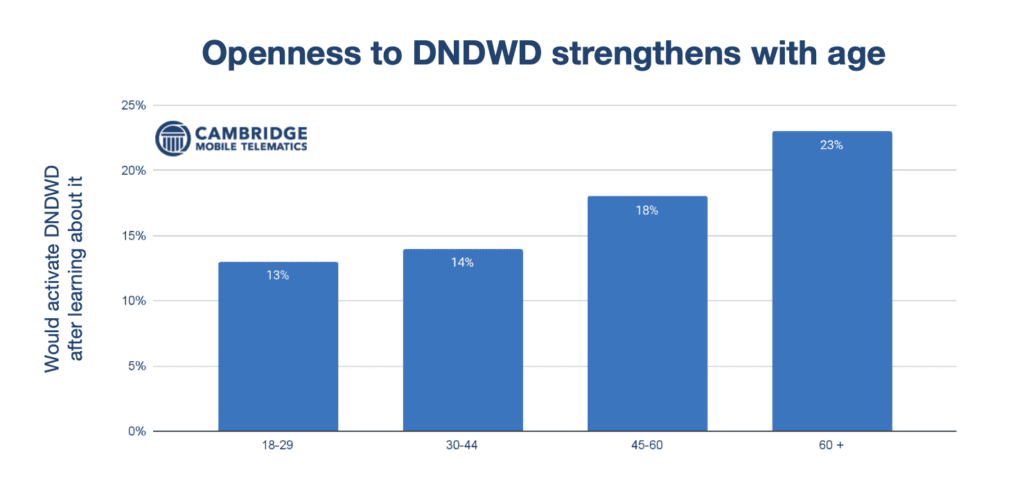
The 18-29-year-olds showed the most resistance. Just 13% percent of them say they would activate DNDWD after learning about it. These results were the opposite of what we saw with awareness and DNDWD activation — results improve as age increases. Fourteen percent of 30-44-year-olds, 18% of 45-60-year-olds, and 23% of people over 60 said they would activate DNDWD now. This finding may offer hope for focusing on older age groups to help them activate the feature.
How can I help spread awareness?
While over 60% of US drivers know about DNDWD, only 20% use it. The younger generation, although more aware with higher usage levels, also shows the most resistance. On the flip side, older individuals have lower awareness and lower usage but seem more inclined to adopt it.
So, where does this leave us?
We clearly need to do more work on educating younger drivers on the benefits of DNDWD and the dangers of distracted driving. And, Apple and Google should be doing more to ensure people are using these features, and making them opt-out instead of opt-in. However, the strategy that everyone reading this can adopt to increase DNDWD usage now is to focus on older populations. Everyone can get involved.
The next time you’re at your grandparent’s house or with older family friends, tell them about the importance of DNDWD. Help set it up for them. Tell them about the dangers of distracted driving, that 34% of drivers who crash are distracted the minute before they crash. The younger, tech-savvy generation can help spread the word about this life-saving feature to the older generation. And, in doing so, they’ll help make roads and drivers safer for everyone.
